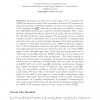Free Online Productivity Tools
i2Speak
i2Symbol
i2OCR
iTex2Img
iWeb2Print
iWeb2Shot
i2Type
iPdf2Split
iPdf2Merge
i2Bopomofo
i2Arabic
i2Style
i2Image
i2PDF
iLatex2Rtf
Sci2ools
WAIM
2007
Springer
2007
Springer
A New DBMS Architecture for DB-IR Integration
Nowadays, as there is an increasing need to integrate the DBMS (for structured data) with Information Retrieval (IR) features (for unstructured data), DB-IR integration becomes one of major challenges in the database area[1,2]. Extensible architectures provided by commercial ORDBMS vendors can be used for DB-IR integration. Here, extensions are implemented using a high-level (typically, SQL-level) interface. We call this architecture loose-coupling. The advantage of loose-coupling is that it is easy to implement. But, it is not preferable for implementing new data types and operations in large databases when high performance is required. In this talk, we present a new DBMS architecture applicable to DB-IR integration, which we call tight-coupling. In tight-coupling, new data types and operations are integrated into the core of the DBMS engine in the extensible type layer. Thus, they are incorporated as the “first-class citizens”[1] within the DBMS architecture and are supported in...
Related Content
| Added | 09 Jun 2010 |
| Updated | 09 Jun 2010 |
| Type | Conference |
| Year | 2007 |
| Where | WAIM |
| Authors | Kyu-Young Whang |
Comments (0)

